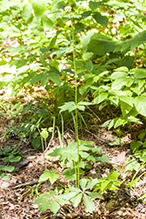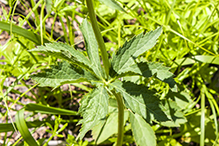Maryland black snakeroot
(Sanicula marilandica)
Conservation • Wetland • Description • Habitat • Ecology • Use • Distribution • Taxonomy
Description |
||
Maryland black snakeroot is a 16″ to 48″ tall, erect, perennial herb that rises on one to several basal leaves and a single stem from a cluster of fibrous roots. The stems are hairless and are usually branched only above the middle. Basal leaves are broadly triangular to egg-shaped or nearly circular in outline and up to 6″ wide. They are on up to 6″ long stalks (petioles) and are palmately divided into 5 leaflets. The lowest two leaflets are deeply cut making the leaf appear to have 7 leaflets. The number of leaflets and apparent leaflets is an important identifying feature. A useful mnemonic for this species is “5 looks like 7”. The leaflets or segments are inversely lance-shaped or inversely egg-shaped, wedge-shaped at the base, and stalkless. The upper and lower surfaces are hairless. The margins are doubly-toothed with sharp, forward-pointing teeth, and are shallowly lobed near the tip. Basal leaves are usually present at flowering time. Stem leaves are alternate. The lowest stem leaves are on long petioles and are similar to basal leaves. They become smaller, less divided, and shorter stalked as they ascend the stem. Middle leaves are on short petioles. The uppermost leaves are stalkless and sometimes appear opposite. The inflorescence is 1 to 5 compound, umbrella-shaped clusters (umbels) at the end of the stem and usually also rising from upper leaf axils. The umbels are subtended by a pair of leaf-like, 3-lobed bracts. The branches of the umbels (rays) are straight, ascending or spreading, and up to 1″ long but unequal in length. At the end of each ray there is a single, ⅜″ to ½″ wide secondary umbel (umbellet). The umbellets may have 12 to 120 flowers but usually have no more than 25 flowers. Some have only male (staminate) flowers. Most have 1 to 4, usually 3, perfect flowers (containing both male and female parts). Each umbellet is subtended by 3 to 9 minute, narrow, toothed bractlets. The perfect flowers are stalkless. The staminate flowers are on 1 ⁄16″ to ⅛″ long stalks and rise above the perfect flowers. Each flower is up to ⅛″ in diameter and has 5 sepals, 5 petals, and 9 to 117 stamens. The sepals are green, 1 ⁄32″ to 1 ⁄16″ long, narrowly lance-shaped to triangular, and slightly fused at the base. They are as long or nearly as long as the petals. The petals are greenish-white, inversely lance-shaped to egg-shaped, and tapered to a slender tip. The stamens have yellow anthers and extend well above the corolla. Perfect flowers have two long, slender, spreading styles. The styles are more than twice as long as the sepals and extend well above the corolla. The fruit is a dry, brownish-green, egg-shaped, ⅛″ to ¼″ long, ⅛″ to 5 ⁄16″ wide, 2-seeded capsule (schizocarp). It is covered with long, hooked bristles, shorter bristles near the base. The base of each bristle is stout and bulbous. The sepals are inconspicuous among the bristles. The persistent styles are much longer than the bristles and are curved backward. The inner face of the split fruit, where the two mericarps meet, is wrinkled and bears a elliptical scar. |
||
Height |
||
16″ to 48″ |
||
Flower Color |
||
Greenish-white |
||
Similar Species |
||
The number of leaflets on the basal and lower stem leaves of black snakeroots (Sanicula spp.) is an important identifying feature. However, the lateral leaflets are often deeply lobed, often to the base, appearing to be two separate leaflets. Canadian black snakeroot (Sanicula canadensis var. canadensis) basal and lower stem leaves are 3-parted with two deeply cut — “3 looks like 5”. There are only 2 to 7 flowers in each flower cluster. The flowers are white. All umbellets include both perfect and male flowers. Perfect flowers are stalked. Male flowers are short-stalked and are concealed by the perfect flowers. The sepals are longer than the petals. The styles are inconspicuous, shorter than the bristles. Clustered black snakeroot (Sanicula odorata) is a smaller plant, no more than 32″ in height. Basal and lower stem leaves are mostly 5-parted — “5 looks like 5”. The flowers are greenish-yellow. Perfect flowers are stalked. Male flowers are short-stalked and are concealed by the perfect flowers. The sepals are much shorter than the petals. Large-fruited black snakeroot (Sanicula trifoliata) is much less common, mostly restricted to the southeastern counties. Basal and lower stem leaves are 3-parted, sometimes with with two deeply cut — “3 looks like 3 (or 5)”. There are only 4 to 11 flowers, usually 7 or fewer, in each flower cluster. The flowers are white. All umbellets include both perfect and male flowers. The sepals in flower are longer than the petals. The styles are inconspicuous, shorter than the bristles. The fruits are ¼″ to 5 ⁄16″ long. The sepals in fruit converge, forming a beak as long or longer than the bristles. Long-styled black snakeroot (Sanicula canadensis var. grandis) basal and lower stem leaves are 3-parted with two deeply cut — “3 looks like 5”. There are only 2 to 7 flowers in each flower cluster. The flowers are white. All umbellets include both perfect and male flowers. Perfect flowers are stalked. Male flowers are short-stalked and are concealed by the perfect flowers. The sepals are longer than the petals. The styles are inconspicuous, shorter than the bristles. |
||
Habitat |
||
Moist, deciduous, mixed, and coniferous woodlands; marsh edges; river banks. Partial sun to medium shade. |
||
Ecology |
||
Flowering |
||
June to August |
||
Pests and Diseases |
||
|
||
Use |
||
|
||
Distribution |
||||
|
Sources |
|||
| 3/25/2023 | ||||
Nativity |
||||
Native |
||||
Occurrence |
||||
Very common and widespread |
||||
Taxonomy |
|||
| Kingdom | Plantae (Plants) | ||
| Subkingdom | Pteridobiotina | ||
| Phylum | Tracheophyta (Vascular Plants) | ||
| Class | Magnoliopsida (Dicots) | ||
Order |
Apiales (Carrots, Ivies, and Allies) | ||
| Suborder | Apiineae | ||
Family |
Apiaceae (carrot) | ||
| Subfamily | Saniculoideae | ||
| Tribe | Saniculeae | ||
Genus |
Sanicula (sanicles) | ||
Subfamily |
|||
Subordinate Taxa |
|||
|
|||
Synonyms |
|||
Sanicula canadesis var. marilandica Sanicula marilandica var. petiolulata |
|||
Common Names |
|||
black sanicle black snakeroot Maryland black snakeroot Maryland black-snakeroot Maryland sanicle |
|||
Glossary
Axil
The upper angle where a branch, stem, leaf stalk, or vein diverges.
Bract
Modified leaf at the base of a flower stalk, flower cluster, or inflorescence.
Bractlet
A small, often secondary bract within an inflorescence; a bract that is borne on a petiole instead of subtending it; bracteole.
Corolla
A collective name for all of the petals of a flower.
Mericarp
The split, usually one-seeded portion of a dry, multi-seeded fruit.
Palmate
Similar to a hand. Having more than three lobes or leaflets that radiate from a single point at the base of the leaf.
Perfect
Referring to a flower that has both male and female reproductive organs.
Petiole
On plants: The stalk of a leaf blade or a compound leaf that attaches it to the stem. On ants and wasps: The constricted first one or two segments of the rear part of the body.
Pistillate
Referring to a flower that has a female reproductive organ (pistil) but does not have male reproductive organs (stamens).
Ray
In the Asteraceae (aster) family: a strap-shaped flower, or the strap-shaped portion of a flower. In the Apiaceae (carrot) and Euphorbiaceae (spurge) families: a branch of an umbel.
Schizocarp
A dry fruit formed from a compound ovary that splits into two or more parts (mericarps) at maturity.
Sepal
An outer floral leaf, usually green but sometimes colored, at the base of a flower.
Staminate
Referring to a flower that has a male reproductive organs (stamens) but does not have a female reproductive organ (pistil).
Style
On plants: Part of the pistil, usually a slender stalk, connecting the ovary to the stigma(s). On flies (Diptera): A terminal, often slender or pointed, appendage arising from the end of the last, usually third, antennal segment.
Umbel
A flat-topped or convex, umbrella-shaped cluster of flowers or buds arising from more or less a single point.
Umbellet
A secondary umbel in a compound umbel.
Visitor Photos |
|||||
Share your photo of this plant. |
|||||
| This button not working for you? Simply email us at info@MinnesotaSeasons.com. Attach one or more photos and, if you like, a caption. |
|||||
|
|||||
MinnesotaSeasons.com Photos |
|||||
Plant |
|||||
 |
|||||
Basal Leaves |
|||||
 |
 |
||||
 |
|||||
Stem Leaves |
|||||
 |
 |
||||
Inflorescence |
|||||
 |
 |
||||
 |
|||||

Slideshows |
||

Visitor Videos |
|||
Share your video of this plant. |
|||
| This button not working for you? Simply email us at info@MinnesotaSeasons.com. Attach a video, a YouTube link, or a cloud storage link. |
|||
Other Videos |
|||

Visitor Sightings |
|||||
Report a sighting of this plant. |
|||||
| This button not working for you? Simply email us at info@MinnesotaSeasons.com. Be sure to include a location. |
|||||
|
|||||
MinnesotaSeasons.com Sightings |
|||||

|
Created: Last Updated: © MinnesotaSeasons.com. All rights reserved. |
